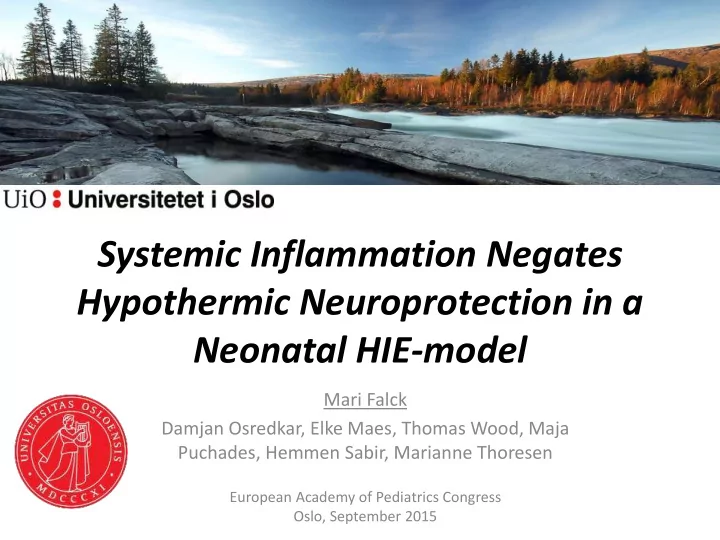

Systemic Inflammation Negates Hypothermic Neuroprotection in a Neonatal HIE-model Mari Falck Damjan Osredkar, Elke Maes, Thomas Wood, Maja Puchades, Hemmen Sabir, Marianne Thoresen European Academy of Pediatrics Congress Oslo, September 2015
Mari Falck and co-authors have documented no financial relationships to disclose or Conflicts of Interest (COIs) to resolve.
Background • 1 million new cases of neonatal encephalopathy each year 1 . • Encephalopathy from HI alone is caused by sentinel events such as – placental abruption – uterine rupture – cord prolapse – shoulder dystocia 2 Blencowe et al, Pediatr Res. 2013 Fleiss et al. Dev Med Child Neurol. 2015
Therapeutic hypothermia (TH) is somewhat neuroprotective: poor outcome 66% 50%. 1 Edwards et al. BMJ. 2010
Neonatal HIE is Likely To Be a Multifactorial Condition With Complex Aetiology Perinatal insult Exacerbation Sensitisation • Postnatal factors • Perinatal factors • Antenatal factors - hypoxia-ischaemia - pain - inflammation - glutamate - drugs - maternal stress - ongoing - inflammation - hypoxia inflammation - oxidative stress - malnutrition - genetic factors - genetic factors - genetic factors Modified from Fleiss et al. Dev Med Child Neurol. 2015
Fetal Exposure to Infection Contributes to the Risk of Hypoxic-Ischemic Encephalopathy. 1 Peebles et al. BJOG. 2002
Experimental 7 day old rat pups (n=153) Design Intraperitoneal injections 8% Oxygen NaCl or LPS Hypoxia (8% O 2 for 50 min at 36°C) 4 hrs Unilateral Ligation
5 hrs NT 5 hrs HT 37°C 32°C Veh=40, LPS=40 Veh=38, LPS=35 24 hrs survival OR 1 week survival Pathology – Area Loss (P14) Western blots Immunohistochemistry
Hypothermia Did Not Offer Any Neuroprotection After LPS+HI Osredkar et al. Resuscitation. 2014
Increased Microglial Activation After LPS+HI Veh LPS = Dapi, nuclei in NT 37°C general = Iba1, microglia specific HT 32°C
Western Blots
LPS Sensitisation Increases Apoptosis
LPS Sensitisation Exacerbates Neuronal Loss
LPS Sensitisation Enhances Astrogliosis
Clinical Relevance • Are we cooling the right cohort? • Should we cool, when there is substantial degree of systemic inflammation? • Further research (pre-clinical and clinical) is needed
Conclusion In a P7 HI rat model with systemic inflammation therapeutic hypothermia is not neuroprotective neither macroscopically, nor on a cellular level .
Thanks to my group! • Professor Marianne Thoresen • Damjan Osredkar • Elke Maes • Thomas Wood • Maja Puchades • Hemmen Sabir • Torun Flatebø • Lars Walløe • Lars Hasvoll Bakke • Maja Elstad • Maria Skytioti • Kristin Bergersen Thoresen group, Oslo, Norway
1. Lee et al. Pediatr. Res 2013. 2. Fleiss et al, Inflammation-induced sensitization of the brian in term infants , Dev. Med. Child Neurol. 2015 3. Edwards et al, Neurological outcomes at 18 months of age after moderate hypothermia for perinatal hypoxic ischaemic encephalopathy: synthesis and meta-analysis of trial data , BMJ 2010 4. Peeples et al, Synergy between antenatal exposure to infection and intrapartum events in causation of perinatal brain injury at term , BJOG 2002 5. Osredkar et al, Hypothermia Does Not Reverse Cellular Responses Caused by Lipopolysaccharide in Neonatal Hypoxic-Ischaemic Brain Injury , Dev. Neuroscience 2015 6. Osredkar et al, Hypothermia is not neuroprotective after infection-sensitized neonatal hypoxic- ischemic brain injury, Resuscitation , 2014 7. asdfkjad
References 1. Lee et al, Pediatr Res. 2013 Dec;74 Suppl 1:50-72. doi: 10.1038/pr.2013.206. 2. Fleiss et al. Dev Med Child Neurol. 2015 Apr;57 Suppl 3:17-28. doi: 10.1111/dmcn.12723. 3. Edwards et al. BMJ. 2010 Feb 9;340:c363. doi: 10.1136/bmj.c363. 4. Eklind et al. Eur J Neurosci. 2001 Mar;13(6):1101-6. 5. Peeples et al. BJOG. 2002 Jul;109(7):737-9. 6. Osredkar et al. Dev Neurosci. 2015;37(4-5):390-7. doi: 10.1159/000430860. 7. Osredkar et al. Resuscitation. 2014 Apr;85(4):567-72. doi: 10.1016. Lee et al, Pediatr Res. 2013 Modified from Fleiss et al. Dev Med Child Neurol. 2015 Edwards et al. BMJ. 2010 Eklind et al. Eur J Neurosci. 2001 Peeples et al. BJOG. 2002 Osredkar et al. Dev Neurosci. 2015 Osredkar et al. Resuscitation. 2014 Modified from Fleiss et al. Dev Med Child Neurol. 2015 Apr;57 Suppl 3:17-28. doi: 10.1111/dmcn.12723. Osredkar et al. Resuscitation. 2014 Apr;85(4):567-72. doi: 10.1016. Osredkar et al. Dev Neurosci. 2015;37(4-5):390-7. doi: 10.1159/000430860. It has even been shown evidence that elective caesarean section was associated with a highly significant reduction in neonatal encephalopathy. This was in a large Australian case-control study of Badawi et al, published in BMJ in 1998. that what we refer to as neonatal hypoxic-ishcemic encephalopathy
Discussion 1. Up-regulation of the innate immune system with early initiation of inflammatory processes by hypoxia leading to glial activation and release of cytotxic cytokines? 2. Increased NO production leading to mitochondrial dysfunction and failure of oxidative phosphorylation? 3. Endotoxin-induced hypoglycaemia impairing the metabolic response to hypoxia? 4. Exacerbation of local tissue ishcaemia via activation of procoagulant molecules and release of casoactive substances such as PAF and endothelial damage? 5. Increased espression of pro-apaptotic molecules such as Fas ligand or TNF?
Hypothermia did not offer any neuroprotection after LPS+HI Osredkar et al. Resuscitation. 2014
Recommend
More recommend